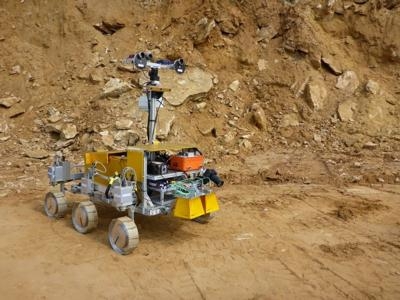Tue, Oct 08, 2013
Will Be Tested On the Atacama Desert In Northern Chile
In what will be ESA’s most ambitious planetary rover test yet, robotic exploration of a Mars-like desert in South America will be overseen from the UK, providing experience for future missions to the Red Planet.

The rover faces the desolate Atacama Desert in northern Chile, one of the closest terrestrial matches for Mars. Among the driest places on Earth, it lacks any vegetation and its red–brown soil and rocks make it look even more like Mars. The aim is to build up experience in operating rovers on a planet, which requires a very different way of working from a satellite mission. For added pressure on the rover’s remote overseers – based at the Satellite Applications Catapult facility in Harwell, UK, next to ESA’s European Centre for Space Applications and Telecommunications – each day of the five-day test will be treated as equivalent to two Mars days, or ‘sols’. For each sol they will first downlink data then prepare a set of commands for the next sol that the rover will then carry out on its own.
The trial is intended to develop technologies and expertise for future Mars missions in general, but for added realism it is using ESA’s 2018 ExoMars rover as its ‘reference mission’.
An early prototype of the six-wheeled ExoMars rover will be put through its paces, fitted with prototypes of three of its scientific instruments: a panoramic camera for stereo 3D imaging, a ground-penetrating radar to probe subsurface geology, and a close-up imager for studying subsurface samples to a resolution of a thousandth of a millimeter. These three instruments will work together to select a sample site with outcrops of bedrock beside looser material. A human-operated hand drill will gather underground samples for the rover to examine – although this human intervention will remain invisible to the remote operators. “This field trial is about optimizing the use of typical instruments and equipment aboard a Mars rover and generating a set of commands for the rover to execute the following day,” explains Michel van Winnendael, overseeing the Sample Acquisition Field Experiment with a Rover, or SAFER, project for ESA. “Unlike satellites, planetary rovers operate in close
interaction with the topography and physical properties of the planetary surface. This implies limited data return from the rover during relatively short communication windows, with an inherent time delay.

“Since drilling plays an important role in the ExoMars rover’s search-for-life strategy, this is an important step. On Mars the best chances of accessing well-preserved molecular biosignatures deposited during the planet’s early, water-rich history lie in the subsurface, at depths below one meter, where the topsoil provides shielding from cosmic radiation damage.”
The precise test location was chosen based on information from local reconnaissance trips made this week by part of the team. Images of the site taken from an unmanned aerial vehicle to simulate the overview from a Mars orbiter will be sent to the remote operators. “Nature is very inventive in presenting situations which were not fully anticipated by those who conceived the mission. That’s why we find it important to do field tests in a fairly representative environment.”
The team in Chile will be accommodated beside the Very Large Telescope on nearby Mount Paranal, as guests of the European Southern Observatory.
(Image provided by ESA)
More News
Newest USAF Drone Begins Process in Earnest The YFQ-42A Collaborative Combat Aircraft has begun its flight testing in coordination with the U.S. Air Force, taking a vital step towa>[...]
“What a great moment for the U.S. Air Force and for GA-ASI. It’s been our collaboration that enabled us to build and fly the YFQ-42A in just over a year. It’s an >[...]
Airline Pilots Jettisoned 15,000 Pounds of Fuel Over Populated Areas Five years after one of its Boeing 777s dumped 15,000 pounds of jet fuel onto neighborhoods, Delta Air Lines ha>[...]
GAO Report Says that Only 69 Aviation Meteorologists Work Alongside ATC A federal watchdog says the FAA is running the nation’s air traffic system with fewer weather experts >[...]
Also: 500-Aircraft Deal With China, Florida ANG's F-35, FAA Denies Petition, UC Central Arkansas Aviation Academy The Reno Air Racing Association (RARA) is offering its apologies t>[...]
 YFQ-42A Collaborative Combat Aircraft Starts Flight Testing
YFQ-42A Collaborative Combat Aircraft Starts Flight Testing Aero-News: Quote of the Day (09.02.25)
Aero-News: Quote of the Day (09.02.25) Delta Settles Fuel Dump Lawsuit in a $78M Handshake
Delta Settles Fuel Dump Lawsuit in a $78M Handshake Watchdog Warns of Another Understaffed FAA Program: Meteorology
Watchdog Warns of Another Understaffed FAA Program: Meteorology Airborne 08.27.25: Air Race Tkt Discounts, Europe AvGas, Deportation Flights?
Airborne 08.27.25: Air Race Tkt Discounts, Europe AvGas, Deportation Flights?




